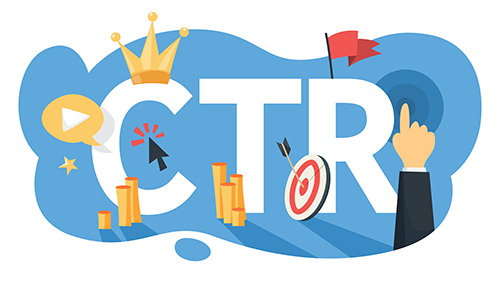What is organic CTR?
Organic CTR or organic click-through rate refers to the percentage of users who click on a given search engine result. It measures the total number of clicks versus the number of impressions.

How far this rate can go depends mainly on how a site is ranked in the SERP. But there are also other factors that influence the CTR, such as the meta description, the URL, the title, etc.
This concept is also used in areas other than search engines. For example, it may refer to the number of clicks a page receives from different sources: emails, social networks, etc.
In other words, the meaning of CTR would be the number of impressions that end in a click. Whatever the objective of each online marketing campaign, you must create relevant content for the audience. And the organic CTR is useful to know if you are on the right track for this purpose.
Why is it important?
There are two main reasons why CTR is particularly relevant. Firstly, a high organic click-through rate is equivalent to more traffic.
Also, the ability to measure CTR makes it easier to optimize content so that it ranks higher. And being able to calculate the success rate results in a better ROI on campaigns.
How to calculate your CTR?
When calculating the organic click-through rate, you should pay attention to four pieces of information that you can get from Google Search Console:
- Keywords for which the site is ranking and the clicks they have achieved.
- The number of impressions.
- In which position the data has been classified.
Next, the CTR formula consists of dividing the total clicks by the sum of impressions within each ranking level.
To perform this operation, follow the next steps:
- Extract the data of the keywords for which the site ranks from Google Search Console.
- Eliminate keywords that are biased (e.g., branded), as they affect the results negatively.
- Search for the keywords with the highest impression levels for each of the collected information. Fortunately, through GSC, we can see which are the keywords with lower impressions. You should eliminate them from the report.
- Depending on the overall volume of data collected, decide how to group each query by ranking position.
- Finally, it’s time to create the CTR curves, placing the position value on the X-axis and the CTR on the Y-axis.
Best practices
We already know what organic CTR is, its importance for SEO, and how to calculate it. Now it’s time to learn what we need to do to improve this parameter:

Track your current organic CTR
It is essential to measure the organic CTR that you currently have to identify and solve the problems that would affect the clicks you get on the site.
You can get a report from Google Search Console with all the details about the organic click-through rate that the website has at a given time.
Improve the speed of your site
The truth is that Google will look closely at how long it takes to load your website before deciding whether or not to reward you in the SERPs. The search engine’s goal is for the user to have the best possible experience when browsing the web, and no one wants to have to wait longer than is strictly necessary to access a page.
Insert images in your publications
To improve click-throughs, you should create posts that contain images, as these increase user engagement on all types of platforms since they especially attract their attention. Also, images can appear in search results, making searchers enter the page through them.
Create the best meta tags (Titles and descriptions)
The quality of the meta title tags and descriptions determines each click from the SERP. Hence the importance of improving them. They tell users what they will find if they click on the result. Therefore, it is essential to pay attention to all your meta tags to increase the click-through rate. Create eye-catching, unique, and descriptive meta tags suitable to the user’s intent.
Optimize for Google’s rich snippets
Adding structured data to your web pages, also known as schema markup, makes them candidates for getting featured snippets on search results. This practice can significantly improve your organic traffic as rich snippets directly provide information of interest to users and make your page stand out in the SERPs. As a result, people will be more tempted to click on your site.
Provide date information to Google
This is not something decisive to rank high on Google, but it can be worth adding your pages’ date of publication or last update, so it appears in the search results since the most recent information is often more attractive to users. You can do so by simply adding your date with text like “Publish” or “Last Updated” in the HTML <body>. Otherwise, you can specify the date with structured data.
Make your favicon appear in the SERPs
Defining a favicon, you can make Google include it in the search results. This will allow users to recognize your brand quickly. To make your favicon appear in Google, you need to add a <link> tag to the <header> of your home page following the next syntax:
<link rel="shortcut icon" href="https://cdn.fandangoseo.com/path/to/favicon.ico">
Translated results
Sometimes Google translates search results to suit the language of the searcher. This happens when Google can find no better option to provide to the user in their own language. By allowing your content to be translated into other languages, you will reach a wider audience.
The languages that Google can currently translate in the SERPs are visible on mobile devices. And they go from English to Indonesian, Hindi, Kannada, Malayalam, Tamil, and Telugu.
To opt-in for translated results, you don’t need to do anything. This feature is applicable to all your pages based on the searcher’s language. To opt-out of the translation feature, you can use the notranslate directive.
<meta name="robots" content="notranslate">
Optimize for Local SEO
The boom in the use of the internet on mobile phones has marked a change in trend. The result of our queries now varies depending on where we are, as Google’s algorithms take care of this.
That’s why you need to optimize your website for local SEO. You should appear on the top of SERPs when users search for information where location matters. So, for example, if someone searches for “Chinese restaurants” but is actually in Berlin, local SEO will serve to get them the content that actually matches what they are probably looking for: Chinese restaurants in Berlin. This will allow you to attract more traffic and leads to your website.
HTTPS Protocol Bounce Rate
